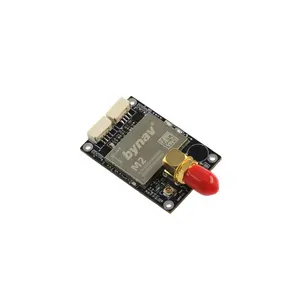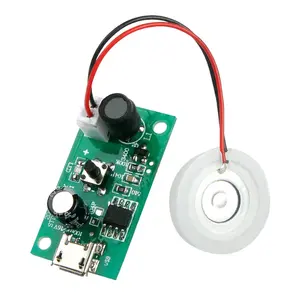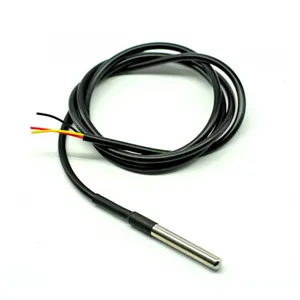Popular in your industry































































Top categories
About fiber optic cable jointing kit
The Definition of Fiber Optic Cable Splicing Kit
A fiber optic cable splicing kit is a specialized tool crafted for the purpose of connecting optical fibers, ensuring effective data transmission in telecommunications, networking, and related fields. Technicians, engineers, and network specialists rely on these kits for tasks involving the installation, maintenance, and repair of fiber optic systems. Splicing entails precisely aligning fiber cores and then fusing or welding them together to establish an uninterrupted optical pathway, facilitating communication between devices over long distances with minimal signal loss.
A fusion splicer, cleaver, fiber holder, power meter, and stripping tool are fundamental components of a fiber optic cable splicing kit. The fusion splicer employs an electric arc to melt fiber ends, which are subsequently fused to form a lasting connection preserving fiber integrity. The cleaver ensures precise fiber cutting before splicing, while the fiber holder aids in maintaining fiber alignment during fusion. The power meter measures the strength of light signals to prevent excessive loss, which could compromise data quality.
The significance of fiber optic cable splicing kits lies in their role in establishing and upholding high-speed Internet connections, cable television networks, and other sophisticated communication systems reliant on fiber optics. They are indispensable in situations requiring cable repair due to damage or when creating new connections to expand or enhance existing networks. Given their deployment in critical infrastructure, the precision and reliability of these kits are paramount, as even minor misalignments or errors could result in significant service disruptions.
Varieties of Fiber Optic Cable Splicing Kits
A diverse range of fiber optic cable splicing kits is available in the market, each tailored to distinct user needs and project requirements. Here is a summary of some common types:
-
Basic Fusion Splicers: These essential devices are used for aligning and fusing fibers to establish a continuous light path. They find application in splicing cables with low to high fiber counts, such as in backbone cabling for large data centers or outdoor installations.
-
Advanced Fusion Splicers: These units offer additional features like automated fiber alignment, multiple core alignment, and precise fiber positioning. They are ideal for intricate networks demanding high precision, as seen in medical imaging or military uses.
-
Portable Splicers: Compact and durable, portable splicers are designed for field technicians to splice fibers on-site. They typically boast rugged designs with advanced features like dust and water resistance for varying environmental conditions.
-
Mass Fusion Splicers: High-end devices capable of aligning and fusing multiple fibers simultaneously. They are employed in scenarios necessitating rapid and efficient splicing of large fiber counts, such as in densely populated data center installations.
-
High-Precision Cleavers: Utilized for precisely cutting fibers for splicing or termination purposes. High-precision cleavers ensure each fiber end is clean and flat, crucial for maintaining signal integrity.
Guidelines for Choosing a Fiber Optic Cable Splicing Kit
Selecting the appropriate Fiber Optic Cable Splicing Kit is vital for businesses seeking to ensure network reliability and performance. When evaluating a kit for your specific application, consider the following factors:
-
Splicing Method: Determine whether you require a kit supporting mechanical splicing or if greater precision is needed with thermal splicing. Mechanical splicing, known for its simplicity and cost-effectiveness, contrasts with thermal splicing, offering enhanced precision for permanent installations.
-
Splicing Quality: Seek kits that guarantee low-loss splices and provide clear instructions to achieve this standard. Some kits incorporate advanced features like automatic alignment, significantly enhancing splice quality.
-
Tool Compatibility: Confirm the kit aligns with the specific splicing tool you intend to use, ensuring the tool accommodates all components included in the kit.
-
Application Environment: Take into account the environment in which splicing will occur. For hazardous settings involving dust or moisture, opt for a kit inclusive of protective gear for technicians and equipment.
-
After-Sales Service: Prioritize suppliers offering comprehensive after-sales support, such as online or video technical assistance, or favorable return policies. These provisions offer reassurance when investing in these critical components.
By meticulously assessing these factors against your business requirements and leveraging the wide array of options from global suppliers available on Alibaba.com, you can make an informed decision aligning with your operational needs.
Insight into Fiber Optic Cable Splicing Kit on Alibaba.com
Alibaba.com serves as a global marketplace connecting businesses with numerous suppliers offering diverse fiber optic cable splicing kits. Catering to operations of any scale, from small IT boutiques to large manufacturing facilities, Alibaba.com streamlines the procurement process via its user-friendly platform enabling buyers to filter options based on their specific needs. Whether in search of basic hand tools or cutting-edge equipment like core alignment fusion splicers, Alibaba.com's extensive network ensures access to quality products facilitating smooth business operations.
Moreover, Alibaba.com's Trade Assurance service enhances transaction security by safeguarding payments until delivery confirmation. This commitment to secure transactions underscores Alibaba.com's dedication to fostering trust within its trading ecosystem. With its extensive selection and reliable supplier network, businesses can confidently fulfill all their fiber optic cable splicing requirements through Alibaba.com, ensuring operational efficiency while adhering to international quality standards.
For businesses seeking tailored solutions tailored to their precise needs, many suppliers on Alibaba.com provide customization options. Whether requiring specialized tools or multifunctional equipment for efficiency, Alibaba.com facilitates these bespoke acquisitions while upholding uncompromised quality standards. This personalized service level positions Alibaba.com as the ideal platform for businesses seeking the finest fiber optic cable splicing kits available in today's market.
Frequently Asked Questions about Fiber Optic Cable Splicing Kit
What is the purpose of a fiber optic cable splicing kit?
Fiber optic cable splicing kits are utilized to join two or more fibers to enable seamless data or signal transmission. They are commonly deployed in telecommunications, data centers, and various industrial settings where high-speed and high-quality splices are essential.
How does a fiber optic cable splicing kit differ from a fusion splicer?
Fiber optic cable splicing kits typically offer more precise control over the splicing process, resulting in higher quality and performance of the splice. Fusion splicers are more efficient in creating a continuous splice by melting the fibers together, reducing installation time and potential signal loss.
Can a mechanical splicing kit be used for all types of fiber optic cables?
Mechanical splicing kits are versatile but not universally suitable. It is crucial to select a kit with connectors and splicing methods that align with the cable's specifications for a reliable splice.
Is a high-end fusion splicing kit necessary?
The necessity for a high-end fusion splicing kit hinges on the specific requirements of your splicing applications. Advanced kits often offer programmable settings, enhanced accuracy, and real-time monitoring, beneficial for complex fusion processes or high-volume splicing tasks.
How can one determine the suitable type of fiber optic cable splicing kit?
To determine the appropriate fiber optic cable splicing kit, consider factors such as the fiber types involved, environmental conditions at the splicing site, required splice precision and durability, and potential benefits of additional features like real-time monitoring or programmable settings.
What are the essential components of a fiber optic cable splicing kit?
The key components typically comprise a fusion splicer machine, a cleaver, a set of splicing electrodes or blades, and possibly a fiber optic stripping tool. Optional components may include a cleaning kit or work table based on the kit contents.
How does one choose between different fusion splicing methods?
Select a fusion splicing method based on factors like fiber type (e.g., single-mode or multimode), environmental conditions at the splice location (e.g., indoor vs. outdoor), required splicing accuracy, installation time preferences, and budget constraints. Mechanical splicing may be quicker but less precise, while fusion splicing offers accuracy suitable for networks with higher bandwidth needs.
What distinguishes single-mode from multimode fiber optic cables?
Single-mode fiber optic cables are crafted for long-distance and high-bandwidth transmission, while multimode cables are optimal for short-range and lower bandwidth applications. The choice depends on network requirements like distance and data transfer speed.
Can fiber optic cable splicing be done without a splicing machine?
While it is feasible to manually align and fuse fiber ends, it is highly recommended to use a specialized machine like a fusion splicer due to the precision required for accurate splicing.
What should be considered when selecting a fiber optic cable splicing kit for harsh environmental conditions?
For harsh environments, opt for kits offering enhanced durability against factors such as temperature fluctuations, water exposure, dust, and vibrations. Features like IP ratings can indicate suitability for such conditions.
Are there specific maintenance requirements for fiber optic cable splicing kits?
Maintenance typically involves keeping the equipment clean and stored appropriately. Some kits may necessitate specific maintenance practices concerning temperature control or regular calibration checks to uphold precision in splicing results.
How can the quality of a fusion splice be ensured?
To ensure quality, purchase from reputable suppliers offering detailed product specifications and positive ratings or reviews. Adhering to intended usage and manufacturer guidelines can also help in maintaining quality.




























